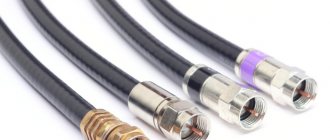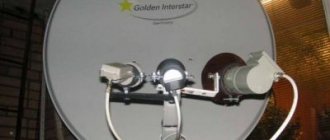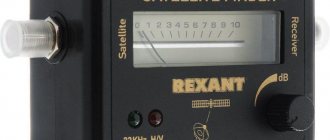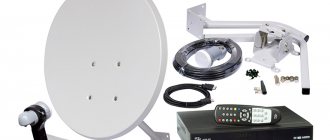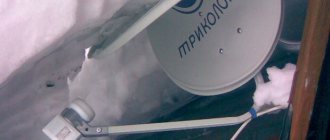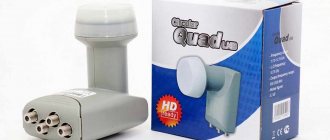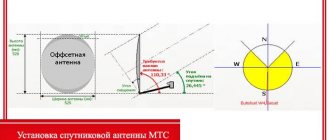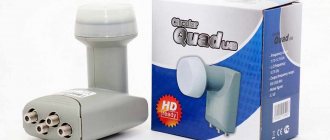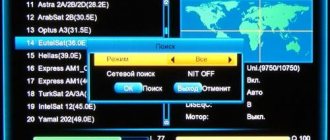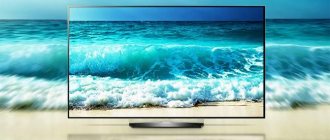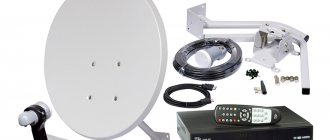Cable for satellite dish. Cable (wire) for collective antenna
Laying a television cable yourself, installing a satellite dish and connecting connectors - these tasks seem overwhelming to many. Therefore, most satellite and terrestrial television subscribers turn to professional installers for help. Meanwhile, all these operations do not require any special knowledge in the field of radio electronics and can be performed by anyone who knows how to use a drill and a screwdriver.
Cable (wire) for satellite dish. Selection, gasket
It should be remembered that the signal received from a satellite on earth is very weak, so the antenna for its reception is more complex than a regular decimeter antenna and its cost is higher. The satellite signal must be “caught”; even a small obstacle (tree branches, wires) between the dish and the open sky can significantly complicate its reception. However, all the efforts spent on the correct installation of the antenna may be in vain if you are not careful when choosing a cable for a satellite dish. A cheap coaxial cable will not work due to the high attenuation coefficient of the high-frequency signal. For a “satellite” cable, the attenuation coefficient at frequencies above 1.5 GHz should not exceed 30 dB/100m. The attenuation coefficient, in turn, is affected by the following cable parameters, which can be viewed in its technical characteristics: 1. The diameter of the central core - the larger the better. 2. The material from which the core is made - pure copper is better than copper-plated steel. 3. Braid material (outer conductor): Aluminum foil in combination with copper braid provides sufficient shielding effect. 4. The dielectric material of the central conductor - physically foamed polyethylene is preferable, since it contains more gas bubbles and its insulating properties are better. Based on all of the above, the ideal option in terms of price/quality ratio would be: SAT 703 (CAVEL company) and H 125 AL (Belden / POPE). When choosing a cable for an antenna, you should take into account the distance over which it will have to be laid. If it is less than 20 meters, you can save money by choosing a cable for a satellite dish with a smaller cross-section of the central conductor. Before buying an antenna wire (cable), you need to measure all the distances “from bend to bend” with a tape measure. Adding the resulting numbers, we get the required length to connect the cable from the antenna to the receiver. You need to add another 1 meter to it just in case. It is better to drill the hole for laying the antenna cable outside in the wall rather than in the window frame. Its diameter should be 2-3 mm larger than the diameter of the cable. That part of the antenna cable that is located on the outside of the wall or on the roof must be secured especially carefully (every 25 cm for vertical and horizontal placement); it should not be thrown from side to side by gusts of wind. It is better not to lay the antenna cable near high-voltage wires, distribution panels and other sources of electromagnetic fields. When laying, do not allow severe deformation of the cable (the permissible bending radius depends on the diameter of the cable) and damage to the external insulation.
Cable for terrestrial signal reception antenna. Selection, gasket
Since in our time most apartment buildings have long received a TV signal via terrestrial communication channels, and not from an antenna located on the roof, you can choose almost any cable to connect the television antenna. In both cases, a regular RG-6 from any manufacturer will do (RK75-4.9-312, RK75-4-11A are made in Russia) with a characteristic impedance of 75 Ohms. The only thing you should pay close attention to is the wiring. There should be one splitter for the entire apartment, regardless of how many rooms and TVs there are. Each unnecessary branching can degrade image quality. If you only need to connect 2-3 TVs to the network, you can do without a splitter and use only TV sockets. It should be remembered that television sockets come in pass-through and end-type types. Serial connection (laying) of a television cable through many pass-through sockets leads to strong signal attenuation, so there should be as few of them as possible in a home TV network.
Connecting the connectors
The television cable is connected to the antenna and receiver using threaded F-connectors. The inner diameter of the connector must match the diameter of the cable, otherwise in order to screw it tightly, you will have to use an additional layer of foil. This is bad because foil is an easily deformable material and over time the connection between the television cable and the connector will lose its density. In order to connect the connector, you need to perform the following operations sequentially: 1. Remove the outer insulating layer at a distance of 1.5 cm from the end of the cable, being careful not to damage the braid and shielding layer of foil. 2. Carefully unwind the braided wire and evenly “lift” it back together with the foil, exposing the central conductor with the dielectric. 3. Expose the central conductor by 0.7 - 1 cm. 4. Screw the connector tightly so that the exposed conductor protrudes from it by 1 -1.5 mm, if necessary, cut off the protruding part of the conductor.
What cable parameters should you pay attention to?
Insulated metal strands that conduct information to video and audio-reproducing connected equipment are characterized by several parameters. These include:
- conductor cross-section and material;
- signal attenuation and gain coefficient;
- wave resistance.
To transmit digital information, the wire resistance must be observed. It must be at least 75 ohms. The cable cross-section depends on the distance to the signal receiver. For example, for a multi-storey building, an average of at least 30 meters is typical. Then the conductor should be about 1 mm in diameter. If this is a private house, then a cross-sectional area of 0.5-0.9 square meters is sufficient. mm.
Regarding the material, both copper, steel, aluminum, and copper-plated alloys cope with conductivity. But manufacturers do not always provide information about attenuation, but this happens rarely. More often than not, the signal amplification factor is sufficient. For good quality, 60-80 dB is enough; with a footage of more than 25 meters, it will be possible to achieve an ideal image with a value exceeding 90 dB. But this is not always necessary.
The last criterion on which the choice of wire is based is the allowable flexibility of the cable. If it contains a core with a cross-section of less than 1 mm and the screen is represented by foil or film, then the risk of fracture of the core and screen increases already at an angle of 45⁰. This phenomenon is eliminated by a thicker core and additional metal braid.
Installation and operation
The antenna cable for the TV is quite resistant to external factors. If there are fluctuations in temperature outside, you should opt for a wire with a steel core, due to its low thermal conductivity. Indoors, on the contrary, it is better to use a copper core. It is extremely important to take into account such nuances, since resistance increases with heating. It helps reduce signal speed. Even the densest double screens offer negligible attenuation rates. So, you need to reduce the distance between the antenna and the TV tuner or purchase an amplifier. In this case, the power consumption of the receiver increases.
Correct installation of coaxial cable for a TV
Modern receivers include fasteners and clamps for simplified connection. However, the most reliable and proven installation method is soldering.
Cable bending problems
One or another bending option implies a significant deterioration in the signal level. This can be avoided by placing the cord at an angle of 90°. However, this increases the absorption of the wire and the risk of destruction of the screen at this point.
Experts recommend, if possible, to avoid sudden changes in the shape of the product. You should adhere to a smooth change of direction within the limits of acceptable flexibility.
Which cable to choose for satellite, digital, cable TV
Direct connection to television equipment does not cause problems or difficulties in selecting the desired type of product. However, a number of older models are not equipped with decoders. For this reason, to watch digital television, you will need to connect a digital receiver. In addition, you need to find a cable to connect the set-top box directly to the TV.
Modern receivers have connectors of various formats, which means a wide selection of cables. They share one important characteristic. We are talking about throughput - it is what is responsible for the maximum image clarity that the wire from the receiver can provide after decoding the digital signal. In other parameters the products are different.
Experts say that purchasing a cord for each type of television is unprofitable. This is due to the fact that the frequencies of such channels do not differ much from each other and fit within the range of 49-800 MHz. Such a gap is qualitatively “covered” by absolutely all types of brands SAT 50, RG 6, SAT 703, DG 113 and RK 75 . If the total wiring length ranges from 20 to 30 meters, feel free to buy one type of product.
Coaxial Cable Specifications
Antenna wire for satellite television
The broadcast frequency of satellite channels ranges from 1-3 GHz, which is extremely different from analog television. They are more susceptible to interference and require effective shielding. In addition, the frequency of data receipt is higher. Focus on the task that the cable must perform - transmit a signal without significant losses. To do this, it must be wider and equipped with an outer shell that is resistant to various weather conditions.
For satellite television, it is recommended to consider values exceeding the optimal characteristics, for example, SAT 50, SAT 703, DG 113.
The structure of a television cable
Absolutely all models of such products have similar content. The components are:
- Inner conductor. It can be made in the form of a single or multi-core wire, as well as a copper tube. Multi-core products are characterized by a greater degree of elasticity and endurance. It can be all copper or copper coated steel.
- Dielectric layer. Provides static position of conductors. The material used for its manufacture is usually polyethylene, fluoroplastic or foamed polyvinyl chloride. Foamed dielectric provides greater flexibility. The only negative is the absorption of moisture, which significantly impairs the functional characteristics.
- Outer conductor, or braid. Has an insulating function. Can be made of foil, corrugated tube, aluminum film, metal wire. Protects the conductor from third-party negative radiation, or electromagnetic interference (EMI).
- Shell. Protecting the internal structure of the wire from the negative influences of climatic and chemical nature.
Coaxial cable for TV
A cable of this structure is also called coaxial . Therefore, everything that is written in this article will help you understand which is the best coaxial cable to buy for your TV.
